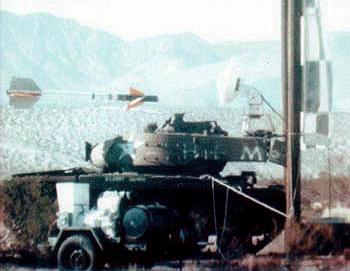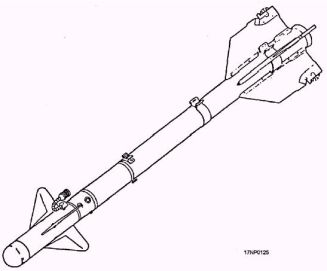Motorola AGM-122 Sidearm
In the early 1980s, the U.S. Navy looked for a way to make use of the stocks of semi-active radar homing AIM-9C Sidewinder missiles, which had been phased out of service. The NWC (Naval Weapons Center) at China Lake developed the Sidearm (for "Sidewinder Anti-Radiation Missile"), a conversion of the AIM-9C to an air-to-ground anti-radiation missile. The first test firing of a prototype conversion occurred in 1981, and in 1984, Motorola was awarded a contract to convert existing AIM-9C missiles into AGM-122A Sidearms. The original narrow-band passive radar seeker of the AIM-9C was substituted by a broader-band seeker, and the DSU-17/B proximity fuze of later Sidewinders was also incorporated into the AGM-122A. While Sidearm is less capable than modern anti-radiation missiles (like AGM-88 HARM), it is still a cost-effective alternative against low-tech threats. Between 1986 and 1990, more than 700 missiles were delivered for use by the U.S. Marine Corps.
 |
 | |
| Photo: U.S. Navy | Drawing: U.S. Navy | |
| AGM-122A | ||
There is also an inert training version designated ATM-122A, and the CATM-122A is a version for captive (non-firing) training.
When the AIM-9C stocks were exhausted at the end of the 1980s, it was proposed to build new missiles as improved AGM-122B. The AGM-122B was to receive a new guidance and control system using reprogrammable EEPROM memory boards. However, this proposal was not adopted, and the AGM-122B was cancelled. The designation CATM-122B was also already allocated for a planned captive-carry training version.
Specifications
Note: Data given by several sources show slight variations. Figures given below may therefore be inaccurate!
Data for AGM-122A:
| Length | 2.87 m (113 in) |
| Finspan | 0.63 m (24.8 in) |
| Diameter | 12.7 cm (5 in) |
| Weight | 88 kg (195 lb) |
| Speed | Mach 2.3 |
| Range | 16.5 km (18000 yd) |
| Propulsion | Hercules MK 36 MOD 11 solid-fuel rocket |
| Warhead | 11 kg (25 lb) WDU-31/B blast-fragmentation |
Main Sources
[1] Norman Friedman: "World Naval Weapons Systems, 1997/98", Naval Institute Press, 1997
[2] Hajime Ozu: "Missile 2000 - Reference Guide to World Missile Systems", Shinkigensha, 2000
Back to Current Designations Of U.S. Unmanned Military Aerospace Vehicles
Back to Directory of U.S. Military Rockets and Missiles
Last Updated: 8 November 2002